The idea of a public park as a benefit for citizens is now well-established, beginning with the building of
New York's Central Park in the 1850s. Its designer, Frederic Law Olmsted, believed that a large open space,
 Central field
with winding paths, small hills and a variety of plantings which offer different views, was relaxing and healthy.
Today we visited Middle Harbor Shoreline Park in Oakland, where his philosophy is well expressed. Unlike a
typical city park with a path, a few benches, a playground, this lovely green space, snaking along the shore
Central field
with winding paths, small hills and a variety of plantings which offer different views, was relaxing and healthy.
Today we visited Middle Harbor Shoreline Park in Oakland, where his philosophy is well expressed. Unlike a
typical city park with a path, a few benches, a playground, this lovely green space, snaking along the shore
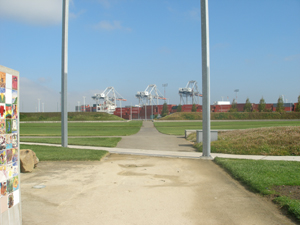 The central fountain areanear an unbelievably busy waterfront industrial area, offers contrast to the commercial activities for people
who want to stroll, sit, or picnic. Shortly after we parked to begin our investigation on a Thursday morning,
a group (almost certainly employees of a nearby company) began setting up the equipment for a barbecue and
picnic luncheon.
The central fountain areanear an unbelievably busy waterfront industrial area, offers contrast to the commercial activities for people
who want to stroll, sit, or picnic. Shortly after we parked to begin our investigation on a Thursday morning,
a group (almost certainly employees of a nearby company) began setting up the equipment for a barbecue and
picnic luncheon.
Immense cranes line the Oakland Estuary, loading and unloading containerized cargo from ocean-going ships.
Trucks fill the streets leading to the docks from the freeway, heading for one or another container terminal.
It seemed we were the only passenger vehicle on the road, but we persevered until we located the entrance to
the park.
This new park, most of which was only opened in 2004, is a jewel in the East Bay Regional Parks system. Just
as urban parks have done for a century or more, Middle Harbor Park provides open space and beautiful lawns for
strolling or picnics, or simply sitting on one of the many benches and watching the waterbirds and, of course,
the waterside commerce. It is new, and parts of it are still unfinished, but the visitor feels welcomed and
comfortable.
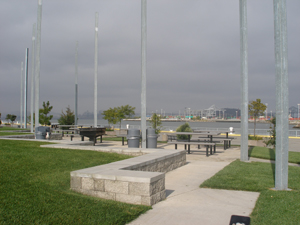 Wall at Supply Depot site
The Port Arnold area of the park is built on the site of the former Oakland Naval Supply Depot, which during
World War II and after was a vital supply depot for the Pacific Fleet. Just about everything the Navy needed
was shipped from this depot, from coffee to weapons and ammunition to library books to medical equipment. Railroad
tracks were laid for the freight trains which ran day and night, delivering material from across the country to this
shipping area. The depot was the site of the first pallet-and-forklift method of moving cargo. The Supply Depot was
essentially a small city, with warehouses and offices, but also all of the special services for its inhabitants --
bowling alley, theater, barracks, chapel. At one point its coffee roasting plant supplied all of the coffee for all
of the American armed forces in the Pacific.
Wall at Supply Depot site
The Port Arnold area of the park is built on the site of the former Oakland Naval Supply Depot, which during
World War II and after was a vital supply depot for the Pacific Fleet. Just about everything the Navy needed
was shipped from this depot, from coffee to weapons and ammunition to library books to medical equipment. Railroad
tracks were laid for the freight trains which ran day and night, delivering material from across the country to this
shipping area. The depot was the site of the first pallet-and-forklift method of moving cargo. The Supply Depot was
essentially a small city, with warehouses and offices, but also all of the special services for its inhabitants --
bowling alley, theater, barracks, chapel. At one point its coffee roasting plant supplied all of the coffee for all
of the American armed forces in the Pacific.
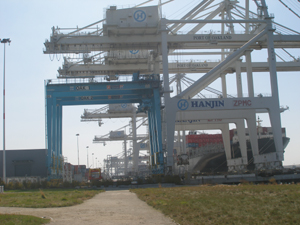 Loading container ships
Loading container ships
The combination of the Supply Depot and the many wartime industries in the Oakland area attracted workers from all
over the country, many of whom stayed after the war, transforming Oakland from a small sleepy city to the richly
diverse giant it is today.
The major part of this park was formerly the site of Building 122, a 190,000-square-foot warehouse (think three
football fields). The building is no longer here, but the park designers have echoed its architectural outline
with zigzag walls and sunshades matching the original rooflines. The landscaping includes man-made hills and large
green spaces punctuated by varied plantings of grasses and shrubs and trees, crossed and traced with walking and
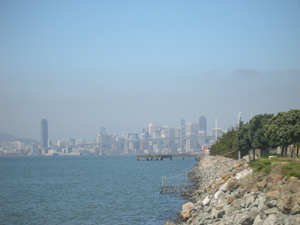 San Francisco from Middle Harbor
bicycle paths winding along a couple of miles of shoreline, and spotted with historical markers, picnic sites, and
intriguing closeup vistas of the waterfront, harbor, marine traffic, Bay Bridge, the former Alameda NAS (where
police cars now practice their high-speed chases), as well as not-so-distant San Francisco.
San Francisco from Middle Harbor
bicycle paths winding along a couple of miles of shoreline, and spotted with historical markers, picnic sites, and
intriguing closeup vistas of the waterfront, harbor, marine traffic, Bay Bridge, the former Alameda NAS (where
police cars now practice their high-speed chases), as well as not-so-distant San Francisco.
At one end is an observation tower providing views of the giant cargo cranes. (They have generously provided free
binoculars mounted on stands near the water, where we watched pelicans, gulls, cormorants and other waterfowl.
Future plans call for extending the marsh and shallow tidelands to encourage more wildlife) Nearby is a reconstructed
jetty, known locally as a training wall. It provided deep enough water in a protected area so that ships could pull
up close to the shore to unload. We spent some time watching a ship being unloaded.
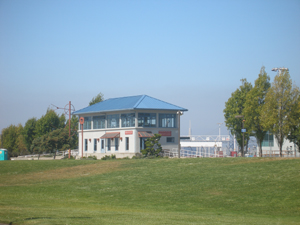 The Train Tower
The Train Tower
At the west end of 7th Street, Port View Park is an older area dominated by the Train Tower Exhibit. In this building,
open weekdays, visitors climb to the second floor where the train controllers used to sit, manipulating the many connecting
train tracks in the freight yards. With up to 160 trains a day, they were kept quite busy. Story board contain photos and
text telling some of the history of the freightyards. The container terminal is named after Ben E. Nutter (1911-2000),
who was CEO of the port of Oakland, and a pioneer in containerized shipping.
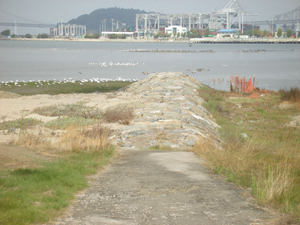 The Training Wall
Near the Train Tower is the International Maritime Center and Seafarers Club, where we chatted with the priest assigned
to the chapel. This organization provides services for the crew members of the ships passing through the port, who
generally have only hours before they must report back for duty. The center offers internet and phone access, a small
library, billiards and ping-pong, a store, and a brief but welcome break from shipboard life.
The Training Wall
Near the Train Tower is the International Maritime Center and Seafarers Club, where we chatted with the priest assigned
to the chapel. This organization provides services for the crew members of the ships passing through the port, who
generally have only hours before they must report back for duty. The center offers internet and phone access, a small
library, billiards and ping-pong, a store, and a brief but welcome break from shipboard life.
Middle Harbor Shoreline Park is, we think, a hidden jewel in the East Bay park system. Who would have thought that
such a pleasant and fascinating oasis would lie hidden among the bustle of one of the busiest harbors in the world?
 Central field
with winding paths, small hills and a variety of plantings which offer different views, was relaxing and healthy.
Today we visited Middle Harbor Shoreline Park in Oakland, where his philosophy is well expressed. Unlike a
typical city park with a path, a few benches, a playground, this lovely green space, snaking along the shore
Central field
with winding paths, small hills and a variety of plantings which offer different views, was relaxing and healthy.
Today we visited Middle Harbor Shoreline Park in Oakland, where his philosophy is well expressed. Unlike a
typical city park with a path, a few benches, a playground, this lovely green space, snaking along the shore
 The central fountain areanear an unbelievably busy waterfront industrial area, offers contrast to the commercial activities for people
who want to stroll, sit, or picnic. Shortly after we parked to begin our investigation on a Thursday morning,
a group (almost certainly employees of a nearby company) began setting up the equipment for a barbecue and
picnic luncheon.
The central fountain areanear an unbelievably busy waterfront industrial area, offers contrast to the commercial activities for people
who want to stroll, sit, or picnic. Shortly after we parked to begin our investigation on a Thursday morning,
a group (almost certainly employees of a nearby company) began setting up the equipment for a barbecue and
picnic luncheon.
 Wall at Supply Depot site
Wall at Supply Depot site Loading container ships
Loading container ships San Francisco from Middle Harbor
San Francisco from Middle Harbor The Train Tower
The Train Tower The Training Wall
The Training Wall